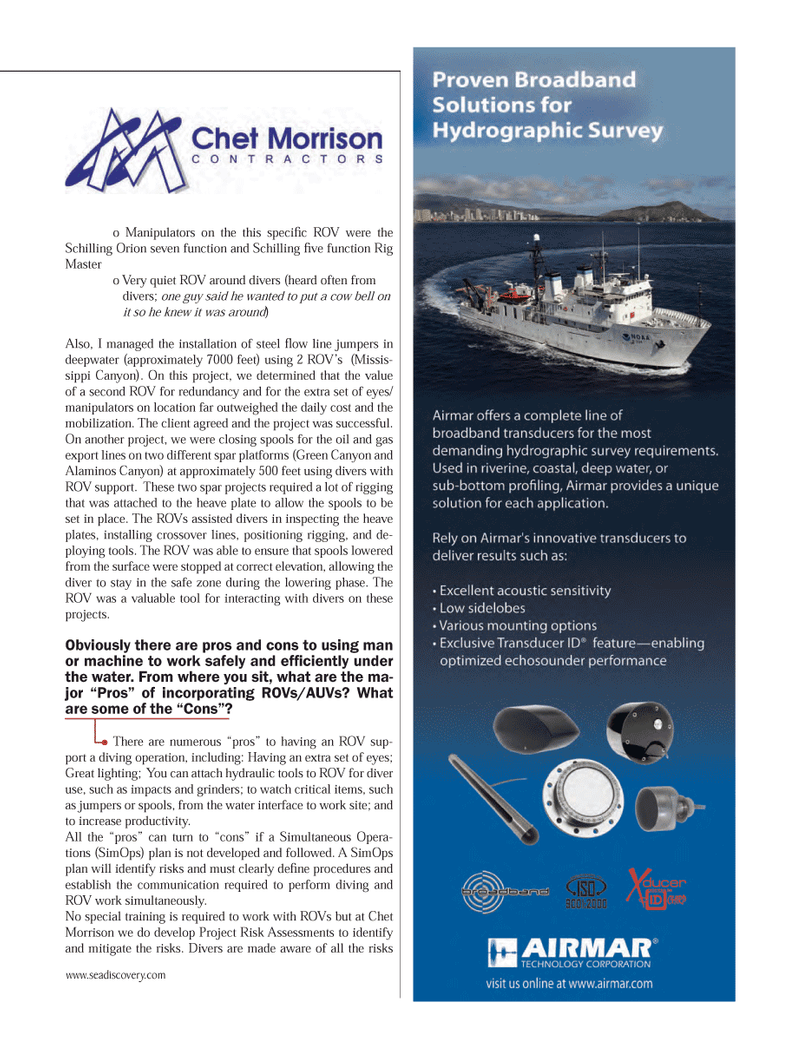
Page 13: of Marine Technology Magazine (November 2012)
Fresh Water Monitoring & Sensors
Read this page in Pdf, Flash or Html5 edition of November 2012 Marine Technology Magazine
o Manipulators on the this speciÞ c ROV were the Schilling Orion seven function and Schilling Þ ve function Rig Master o Very quiet ROV around divers (heard often from divers; one guy said he wanted to put a cow bell on it so he knew it was around )Also, I managed the installation of steel ß ow line jumpers in deepwater (approximately 7000 feet) using 2 ROVÕs (Missis- sippi Canyon). On this project, we determined that the value of a second ROV for redundancy and for the extra set of eyes/ manipulators on location far outweighed the daily cost and the mobilization. The client agreed and the project was successful. On another project, we were closing spools for the oil and gas export lines on two different spar platforms (Green Canyon and Alaminos Canyon) at approximately 500 feet using divers with ROV support. These two spar projects required a lot of rigging that was attached to the heave plate to allow the spools to be set in place. The ROVs assisted divers in inspecting the heave plates, installing crossover lines, positioning rigging, and de- ploying tools. The ROV was able to ensure that spools lowered from the surface were stopped at correct elevation, allowing the diver to stay in the safe zone during the lowering phase. The ROV was a valuable tool for interacting with divers on these projects.Obviously there are pros and cons to using man or machine to work safely and ef Þ ciently under the water. From where you sit, what are the ma- jor ?Pros? of incorporating ROVs/AUVs? What are some of the ?Cons?? There are numerous ÒprosÓ to having an ROV sup- port a diving operation, including: Having an extra set of eyes; Great lighting; You can attach hydraulic tools to ROV for diver use, such as impacts and grinders; to watch critical items, such as jumpers or spools, from the water interface to work site; and to increase productivity. All the ÒprosÓ can turn to ÒconsÓ if a Simultaneous Opera-tions (SimOps) plan is not developed and followed. A SimOps plan will identify risks and must clearly deÞ ne procedures and establish the communication required to perform diving and ROV work simultaneously. No special training is required to work with ROVs but at Chet Morrison we do develop Project Risk Assessments to identify and mitigate the risks. Divers are made aware of all the risks www.seadiscovery.com MTR #9 (1-17).indd 13MTR #9 (1-17).indd 1311/29/2012 10:16:14 AM11/29/2012 10:16:14 AM

 12
12

 14
14
